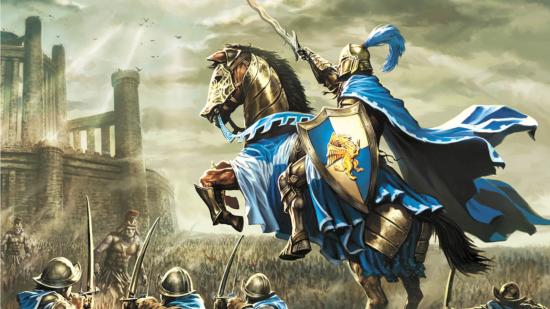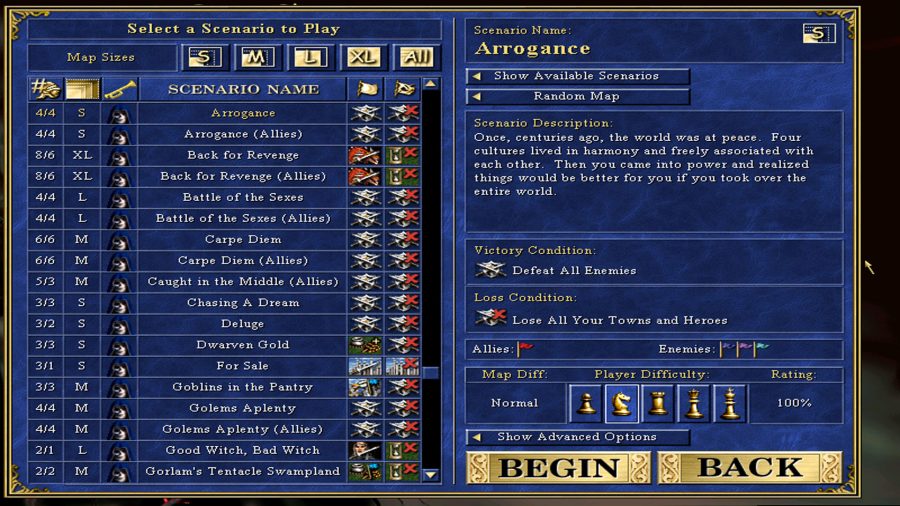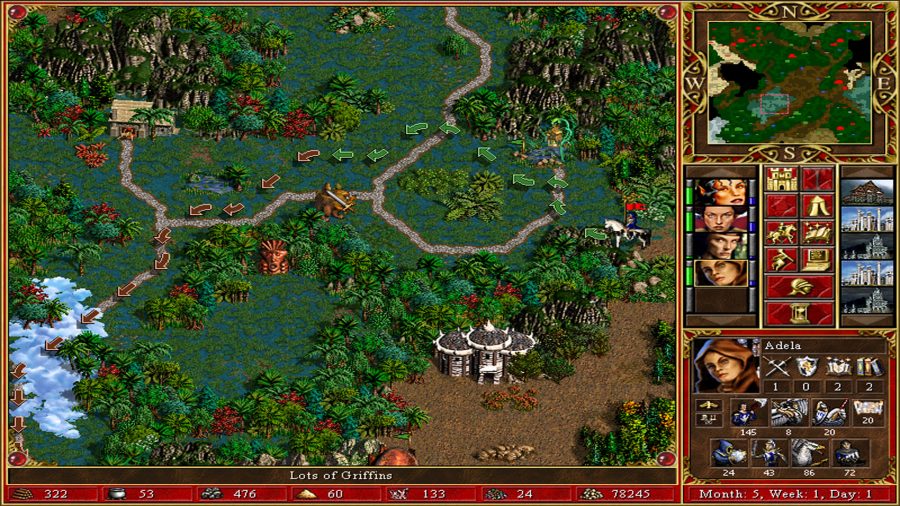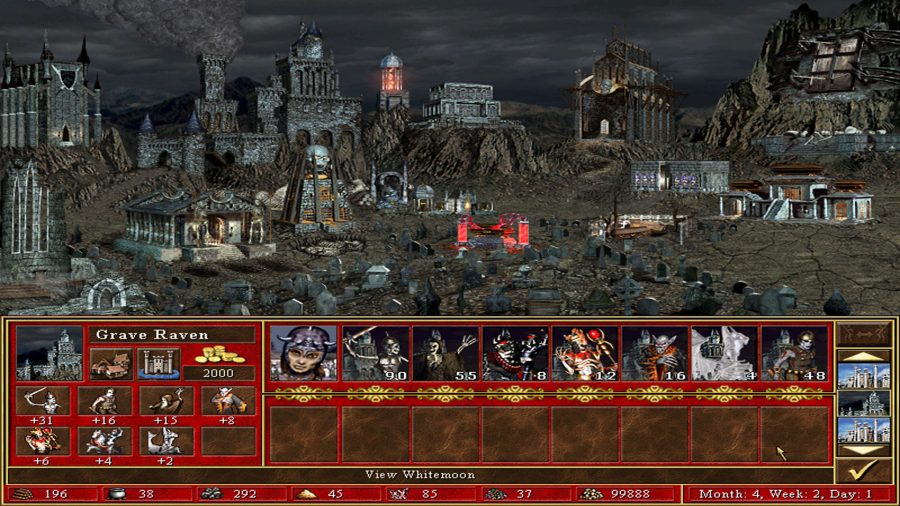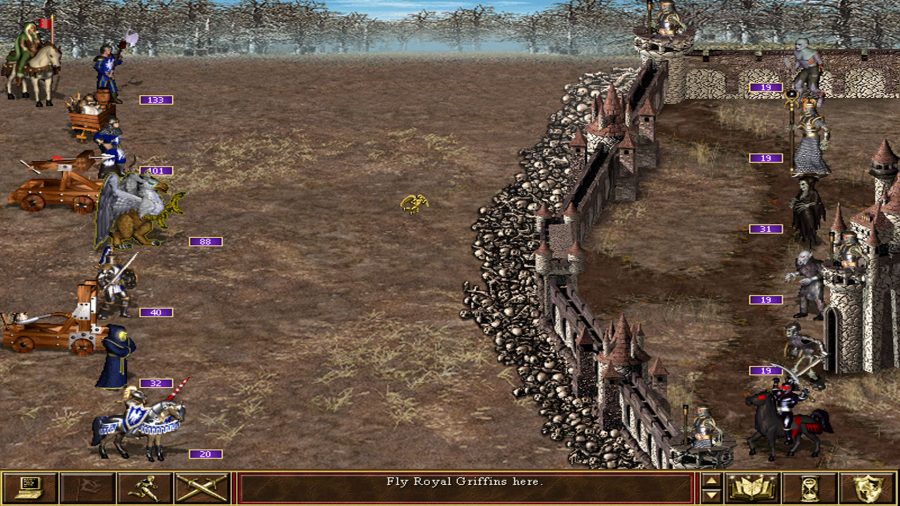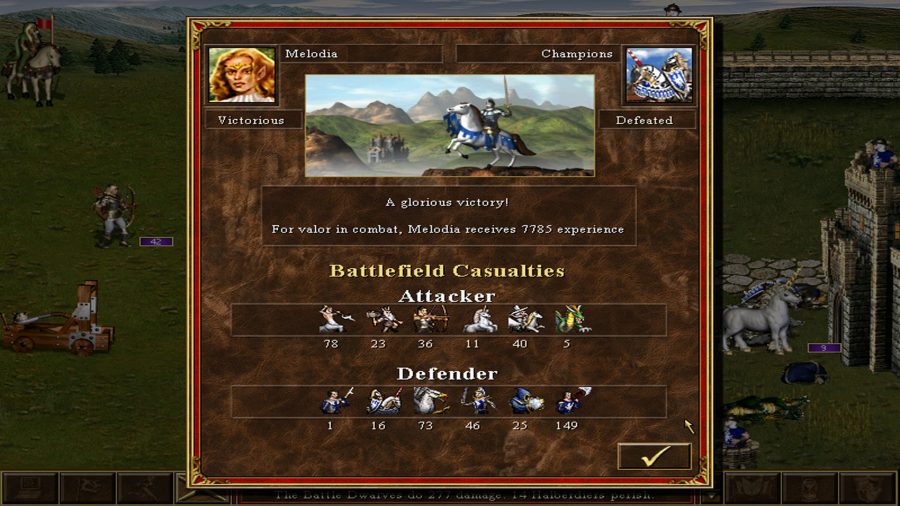Released in 1999, Heroes of Might and Magic III: The Restoration of Erathia is a turn-based strategy game developed by New World Computing and first published by the 3DO Company. It got its gameplay inspiration from what is now considered the forerunner for the whole HoMM series, 1990’s King’s Bounty – another turn-based game developed by the same company. In the year it was released, the game achieved high marks all around, going as far as almost winning the best strategy game of the year.
Following the same style as its predecessors, the game is all about collecting resources, developing your centre, creating an army full of fantastical creatures and capturing other towns. The game received two expansions – 1999’s Armageddon’s Blade & 2000’s Shadow of Death – which added more campaigns and a ninth faction to choose from.
Over the years, there’s been endless arguments over which HoMM game is the best in the franchise. Although opinions regarding older games can be heavily influenced by nostalgia, many arguments can be made that the third instalment is the best and most important of them.
When it’s Heroes 3 against all the others, Heroes 3 wins
Heroes of Might and Magic III set out to be an updated version of the second game in the series, without making any drastic changes to it. They wanted to take a well loved game and give the fans more of it, and that’s exactly what they did. Without modifying the gameplay all that much, they gave an extra two factions (3 counting the DLC) and made the creatures available more thematic to each town, even adding an extra unit to them while making sure each had an upgrade. They also added abilities to the heroes, allowing them to develop more through battles and giving players a bigger choice in which skills they would learn.
Other additions included subterranean levels, bigger maps and more objectives aside from capturing your adversary’s town(s); you may also need to find the Holy Grail, or capture an abandoned city that is lost somewhere in the map. I’ll never forget when my cousin and I were playing and absolutely destroying my sibling’s armies when they, with one day left to find a new town to remain in the game, found the castle that was the map’s main objective, giving them instant victory… RIP. With over 50 skirmish maps and many that allow you to have allies, the third game is still unmatched in the single and multiplayer scenarios, allowing you to quickly amount to over 100 hours ingame.
After finding the perfect formula in Heroes III, Ubisoft only needed to do what had been done between this and the second game: improve on what existed without trying to actually modify key features of the game. The games that followed, although mostly enjoyable were not as addictive. Following the huge success of the third game, Heroes IV had a difficult task ahead from the start and, unfortunately, it didn’t quite succeed. Released in 2002, the game introduced many changes to the gameplay that ended up being greatly criticised.
Amongst plenty of complaints about graphics, the change of the battle grid and a significant reduction of creatures and towns available, a big one was about the heroes. They could now attack without magic, but the game also made it so you could have more than one hero in your army or none at all. With one of the main premises of the game being having a hero (it’s right there, in the title!), mastering either might or magic, that commands armies, taking that away from the players proved to be a very unpopular decision. It did, however, add one successful feature: the caravans, which allowed you to send troops recruited around the map to be sent directly to your town – something that returned in Heroes V (as an add-on) and Heroes VII.
Heroes V to VII saw the franchise go from 2D to full 3D. Though they look very nice (especially the models on VII, which look absurdly good), it felt like losing the charm Heroes II and III’s art had. It became, in a way, a generic looking 3D game, with graphics a little too similar to games like Warcraft 3 – while not a bad thing, it doesn’t stand out as much. After the debacle of Heroes IV, the series reverted closer to Heroes III gameplay, adding some things here and there that, while interesting, didn’t really work that well. Heroes V got a tree system in towns, meaning you could not see all the constructions in the beginning, which hampered planning.
Measure of Success
HoMM 3 was a success from the moment it was released, especially for a turn-based game. While more famous RTS titles, such as the highly anticipated Age of Empires II, sold around 2 million copies by January, 2000; Heroes III managed to sell an impressive 1.5 million copies by December 1999, even with its more old-fashioned turn-based style.
Its influence reached so far and for so long that it’s the most streamed of the franchise and the only game in the series to get a re-release, which was put out in the as Heroes of Might and Magic VII, in 2015. Coincidentally, there haven’t been any further new HoMM games since then.
More like this: Check out the best strategy games on PC
The simplicity of 2D maps, popup windows and charming improved art style make the screen quite easy on the eyes. While very colourful and full of little places to visit, the maps don’t get overwhelming even after playing for hours on end.
Furthermore, another of the reasons that the game attracted so many people to it to begin with, was the improved Hot-Seat multiplayer option. Released at a time when computers were becoming more common in households, but internet only reached around 4.1% of the international population, Heroes provided gamers with an opportunity to play a strategic game with others using only one computer – something that still holds a lot of value today when you can’t use Wi-Fi for some reason or other and want to play a game by yourself or with nearby friends.
The main complaints Heroes III received were regarding its campaign, which was considered broken and oddly paced. Instead of a linear story that would take you through every faction, you instead have five individual ones where you have to start all over again each time. They are also not ordered in a rising level of difficulty, for example having a very hard last mission on an otherwise easy campaign. Although true and disappointing, the campaigns provided by the expansions were a huge improvement, making them more interesting and evenly paced. Nonetheless, the gameplay remained fun through it all.
The legacy of Heroes 3
I’ve been arguing that Heroes III is the best of the franchise with each new addition and often heard that it was merely nostalgia. While I recognise that it does play a part in it, it doesn’t change it being the most liked game in the franchise by fans and critics alike. It is also important to look at the context in which it was released, and what it meant to the community at the time. Nowadays, Heroes III is a game that will run on any laptop, even having versions for mobile phones and tablets. Its simplicity in style and intuitive frame allows even people who do not speak English fluently to play and actually do reasonably well in the game.
While the other games tried, they missed the mark with little things here and there – which ultimately doesn’t really stop one from enjoying playing them. I particularly like Heroes V and VII, despite their glitches and some modifications, I do love the graphics and enjoy seeing some of the features and models from the third game in 3D models – even if they lose some of its charm. From the get go, however, Heroes III was a game that achieved what it set out to do: an improved, more complete version of its predecessor. It fixed all the small issues Heroes II had, and expanded the universe in a way that made it the well-rounded game it is.
Great! I am convinced and want to buy; where can I do that?
Well, Ubisoft re-released it in 2015 on Steam as a HD edition, but without the DLCs due the loss of their code. It is a big drawback, since it takes away over 10 campaigns from the game. Fortunately, you can purchase the game on GOG (for a lower price and with the two DLCs) and can even choose the bundle with games I thru V for not much more. Although GOG’s is the original and not HD you can just download the HD mod – and to play it online, you can always use GameRanger.
